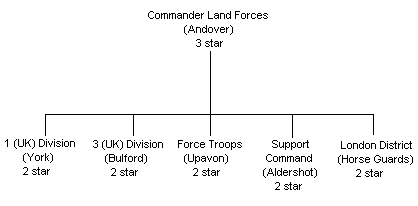|
Commander Land
Forces (CLF)
CLF’s Headquarters (HQ Land Forces) is located at Andover in Hampshire
and commands almost 100 per cent of the Army’s fighting capability. This
capability is organised into four formations (plus London District) and
are commanded by Major Generals.
CLF’s role is to deliver and sustain the Army's operational capability,
whenever required. For operations, CLF would deliver the required force
package (drawn from formations or units under his command) to the
Commander Joint Forces (CJF) for deployment worldwide.
Under his command CLF has almost all the Army's fighting equipment,
including attack helicopters, Challenger 2 tanks, Warrior Infantry
Fighting Vehicles, AS90 guns and the Guided Multi Launched Rocket System
(GMLRS).
Since late 2014, Lieutenant General James Everard has been the
Commander-in-Chief Land Forces.
Commander Land Forces (CLF) Structure
 Note:
Stars denote the rank of the incumbent: 4 star - General; 3 star -
Lieutenant General; 2 star - Major General; 1 star -
Brigadier. CLF has
Operational Control of the Joint Helicopter Command (JHC).
CLF is also responsible for the drawdown and return to the UK of units
from British Forces Germany (BFG). The majority of combat units will be
stationed in the UK by the end of 2015. Reports during mid 2015 suggest
that CLF may establish another subsidiary headquarters to command
formations assigned to the Field Army.
1 (UK) Division is ‘The Adaptable Force’ and 3 (UK) Division is the
‘Reaction Force’.
The Reaction Force – 3 United Kingdom Division: This formation
provides the high readiness elements that will undertake short notice
contingency tasks and provided the conventional deterrence for Defence.
Trained and equipped to undertake the full spectrum of intervention
tasks, this force based upon three armoured infantry brigades under a
divisional headquarters with associated support elements and an air
assault brigade, will provide the building blocks for any future
enduring operation. Given the high readiness nature of this force, it
will comprise predominantly Regular Forces with about 10% being drawn
from the Reserve Forces.
The Adaptable Force – 1 United Kingdom Division: This formation
comprises a pool of Regular and Reserve units organised during peace
under seven regionally based infantry brigades for training and
administrative purposes. For a given operation, force package could be
selected from across the pool of Adaptable Force units. In addition to
providing forces for operational tasks when required, the Adaptable
Force will deliver the elements required for the Standing Commitments in
areas such as Cyprus, Brunei and the Falkland Islands plus Ceremonial
Duties in the UK and for UN commitments as they occur.
The Adaptable Force will also be capable of undertaking the following
tasks:
-
Overseas military capacity building -
training and developing indigenous armies in order to strengthen their
national defence capability and prevent future conflict.
-
Military support to homeland resilience -
this would include maintaining a contingent capability to deal with
natural disasters and other tasks.
-
Providing follow-on forces for future
enduring operations. This would require the Adaptable Force to maintain
institutional readiness at an appropriate level of training.
|